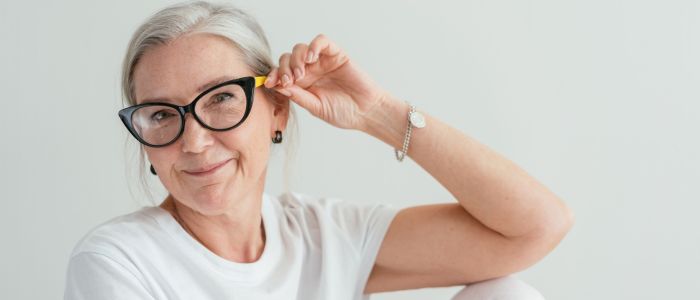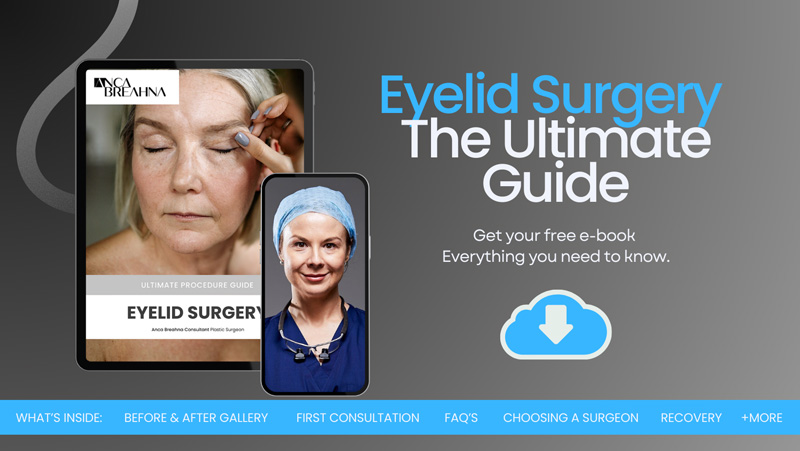
The Benefits of Blepharoplasty for Seniors – Enhancing Vision and Quality of Life
As you age, you may notice changes in your appearance, particularly around your eyes. Sagging eyelids, wrinkles, and puffiness can not only affect your self-confidence but also impair your vision. If you’re a senior experiencing these concerns, you may be wondering if there’s a solution that can help you look and feel your best while improving your quality of life. In this blog post, Consultant Plastic Surgeon Anca Breahna will introduce you to blepharoplasty, a surgical procedure designed to rejuvenate the appearance of your eyelids and enhance your vision. As a Consultant Plastic Surgeon with extensive experience in performing blepharoplasty for seniors, Anca is here to guide you through the process and answer any questions you may have.
Download the Eyelid Surgery Guide

Overview of Blepharoplasty
Blepharoplasty is a surgical procedure that aims to improve the appearance of your eyelids and address any functional issues caused by sagging skin or excess fat. The procedure involves removing excess skin, muscle, and fat from the upper and/or lower eyelids, creating a more youthful and refreshed appearance. There are two main types of blepharoplasty: upper eyelid surgery and lower eyelid surgery. Upper eyelid surgery focuses on removing excess skin and fat that may be causing your eyelids to droop, while lower eyelid surgery targets bags, puffiness, and wrinkles beneath the eyes. In some cases, both upper and lower eyelid surgery may be recommended to achieve the best results.
Ideal candidates for blepharoplasty are typically seniors who are in good overall health and have realistic expectations about the outcome of the procedure. If you’re experiencing sagging eyelids that interfere with your vision, or if you have excess skin and wrinkles around your eyes that make you look older or more tired than you feel, you may be an excellent candidate for blepharoplasty. During your consultation, Anca will assess your individual needs and concerns to determine whether blepharoplasty is the right choice for you.
Common Vision and Quality of Life Concerns for Seniors
As we age, our bodies undergo various changes, and the delicate skin around our eyes is no exception. For many seniors, these age-related changes can lead to a range of vision and quality of life concerns that can have a significant impact on daily activities and overall well-being.
One of the most common concerns for seniors is sagging eyelids, which can occur due to a loss of elasticity in the skin and weakening of the muscles that support the eyelids. As the skin loses its firmness and the muscles become less taut, the upper eyelids may begin to droop, while the lower eyelids may develop bags or puffiness. These changes can not only make you look older and more tired but also impair your vision. Sagging upper eyelids can hood your eyes, reducing your peripheral vision and making it difficult to see clearly. In severe cases, the eyelids may droop so low that they partially or completely block your vision, affecting your ability to perform daily tasks such as reading, driving, or watching television.
In addition to the functional impact of sagging eyelids, many seniors also experience emotional and psychological effects related to the aged appearance of their eyes. Excess skin and fat around the eyes can create a perpetually tired or sad expression, even when you feel energetic and happy. This can lead to feelings of self-consciousness and a lack of confidence in social situations.
Another common concern for seniors is the difficulty in applying makeup or wearing glasses comfortably due to the excess skin and wrinkles around the eyes. Makeup application can become a frustrating and time-consuming task, as the sagging skin and creases make it challenging to achieve a smooth, even look. Additionally, the excess skin may interfere with the proper fit of eyeglasses, causing them to slip down your nose or sit unevenly on your face. This can lead to discomfort and may even cause headaches or eye strain.
The emotional and psychological effects of age-related changes around the eyes cannot be overstated. Many seniors report feeling less confident and less engaged in life as a result of the ageing appearance. These feelings can lead to social isolation, depression, and a general reduction in quality of life. It’s important to recognise that these feelings are valid and that there are solutions available to help you regain a sense of confidence and vitality.
Benefits of Blepharoplasty for Seniors
As a senior, you may be wondering whether blepharoplasty is the right choice for you. While the decision to undergo any surgical procedure should be made after careful consideration and consultation with a qualified plastic surgeon, it’s important to understand the numerous benefits that blepharoplasty can offer.
- One of the most significant benefits of blepharoplasty for seniors is improved vision and peripheral vision. As mentioned earlier, sagging eyelids can hood your eyes, reducing your ability to see clearly and fully. This can be particularly dangerous when driving, as your peripheral vision may be compromised, making it difficult to spot potential hazards on the road. By removing the excess skin and tightening the remaining skin, blepharoplasty can restore your full field of vision, allowing you to see more clearly and reducing the risk of accidents.
- In addition to the functional benefits, blepharoplasty can also provide a refreshed and more youthful appearance. As we age, the skin around our eyes loses elasticity, leading to wrinkles, bags, and sagging. These changes can make us look older, tired, and less vibrant, even when we feel young and energetic on the inside. By removing excess skin and fat, and tightening the remaining skin, blepharoplasty can help to restore a more youthful, refreshed appearance to your eyes. This can have a significant impact on your overall appearance, making you look more alert, engaged, and alive.
- Another key benefit of blepharoplasty for seniors is increased self-confidence and overall quality of life. As we age, it’s natural to feel less confident in our appearance, particularly if we feel that our eyes are making us look older or more tired than we feel. This lack of confidence can lead to social isolation, depression, and a general reduction in quality of life. By restoring a more youthful, refreshed appearance to your eyes, blepharoplasty can help you to feel more confident and self-assured, both in social situations and in your daily life.
- Blepharoplasty can enable you to engage in activities with greater ease and comfort. If you wear glasses, you may have found that excess skin and wrinkles around your eyes can interfere with the proper fit of your glasses, causing discomfort and even headaches. Similarly, if you enjoy activities such as reading, watching television, or using a computer, sagging eyelids can make these activities more difficult and less enjoyable. By removing excess skin and tightening the remaining skin, blepharoplasty can make it easier and more comfortable to wear glasses and engage in these activities, allowing you to enjoy your hobbies and pursuits to the fullest.
It’s important to note that while blepharoplasty can provide significant benefits for seniors, it’s not the right choice for everyone. As with any surgical procedure, there are risks and potential complications to consider, and it’s important to have realistic expectations about the outcome of the procedure. During your consultation with Anca, she will carefully assess your individual needs and concerns, and help you to determine whether blepharoplasty is the best option for you. If you decide to move forward with the procedure, Anca will work closely with you to develop a personalised treatment plan that takes into account your unique goals and circumstances.
Popular Concerns Regarding Blepharoplasty for Seniors
As a senior considering blepharoplasty, it’s natural to have questions and concerns about the procedure. Here are some of the most common concerns that we hear from patients:
Is blepharoplasty safe for seniors?
- Yes, blepharoplasty is generally considered a safe procedure for seniors who are in good overall health. As with any surgical procedure, there are certain risks and potential complications to be aware of, such as infection, bleeding, or adverse reactions to anaesthesia. However, these risks can be minimised by choosing a qualified and experienced plastic surgeon, and by carefully following all pre- and post-operative instructions. During your consultation with me, Anca will carefully assess your medical history and current health status to determine whether blepharoplasty is a safe and appropriate option for you.
How long is the recovery time, and what can I expect during recovery?
- Most patients can expect to take around 1-2 weeks off from work and other normal activities to allow for proper healing after blepharoplasty. During this time, you may experience some swelling, bruising, and discomfort around your eyes, which can be managed with pain medication and cold compresses. It’s important to rest and avoid strenuous activities during this time, to allow your body to heal properly. Anca will provide you with detailed instructions on how to care for your eyes during the recovery process, and will be available to answer any questions or concerns that you may have.
Will the results look natural, or will it be obvious that I had surgery?
- When performed by a skilled and experienced plastic surgeon, blepharoplasty can create very natural-looking results that enhance your appearance without looking “done” or artificial. Anca takes great care to create a customised treatment plan for each of her patients, taking into account their unique facial structure, skin type, and aesthetic goals. The aim is always to create a refreshed, rejuvenated appearance that looks natural and harmonious with your overall facial features.
How long do the results last, and will I need additional procedures in the future?
- The results of blepharoplasty are generally long-lasting, but it’s important to remember that the ageing process will continue even after the procedure. Most patients can expect to enjoy the benefits of blepharoplasty for many years, but may eventually notice some gradual changes in the appearance of their eyes over time. In some cases, a touch-up procedure may be recommended to maintain the results of the initial surgery.
Are there any non-surgical alternatives to blepharoplasty?
- While there are certain non-surgical treatments that can help to improve the appearance of the eyes, such as dermal fillers or laser resurfacing, these treatments are generally not as effective as blepharoplasty for addressing significant sagging, excess skin, or vision impairment. In some cases, a combination of surgical and non-surgical treatments may be recommended to achieve the best possible results.
More FAQs about Blepharoplasty for Seniors
Can blepharoplasty be combined with other facial rejuvenation procedures?
- Yes, blepharoplasty can often be combined with other facial rejuvenation procedures, such as a facelift, brow lift, or dermal fillers, to achieve a more comprehensive rejuvenation of the face. During your consultation, Anca will assess your individual needs and goals, and recommend the best combination of procedures to help you achieve your desired results.
Will I have visible scars after blepharoplasty?
- Blepharoplasty incisions are typically made in the natural creases of the eyelids or along the lash line, which helps to minimise the visibility of any scarring. In most cases, the scars will fade over time and become barely noticeable. Anca uses precise, meticulous techniques to ensure the best possible cosmetic results and minimal scarring.
Is blepharoplasty covered by insurance?
- In some cases, blepharoplasty may be covered by insurance if the procedure is deemed medically necessary to improve vision or alleviate other eye-related issues. However, if the procedure is being performed for cosmetic purposes, it is typically not covered by insurance. Check with your insurance provider to determine your coverage options.
Can I wear contact lenses after blepharoplasty?
- You will need to avoid wearing contact lenses for a period of time after blepharoplasty to allow your eyes to heal properly. The exact length of time will depend on your individual case, but most patients can resume wearing contact lenses after 2-4 weeks.
How can I prepare for my blepharoplasty procedure?
To prepare for your blepharoplasty procedure, Anca recommends that you:
- Stop smoking at least 4-6 weeks before surgery, as smoking can impair healing and increase the risk of complications.
- Avoid taking certain medications, such as aspirin or other blood-thinning drugs, for at least 2 weeks before surgery, as these can increase the risk of bleeding.
- Arrange for someone to drive you home after the procedure and stay with you for the first 24-48 hours to assist with your recovery.
- Follow any specific pre-operative instructions provided by me, such as fasting before surgery or using certain eye drops.
Further Reading about Blepharoplasty with Consultant Plastic Surgeon Anca Breahna
- Read more about Blepharoplasty and Contact Lenses
- Read more about What Do Blepharoplasty Scars Look Like?
- Read more about How to Reduce Swelling and Bruising after Blepharoplasty Surgery
- Read more about Upper Blepharoplasty Recovery Day by Day
- Read more about Non-Surgical Alternatives to Blepharoplasty: Do They Really Work?
- Read more about When to Exercise after Blepharoplasty
- Read more about Preventing Complications in Blepharoplasty
Medical References about Blepharoplasty for Seniors
- Factors Influencing Patient Satisfaction with Upper Blepharoplasty in Elderly Patients
- Safety and Pitfalls of Blepharoptosis Surgery in Elderly People
- Association of Upper Eyelid Ptosis Repair and Blepharoplasty With Headache-Related Quality of Life
- Study to the Effect of Involutional Blepharoptosis Surgery Using Objective and Subjective Parameters
- Blepharoplasty – an overview | ScienceDirect Topics


 Ms Anca Breahna, PhD, MSc, FEBOPRAS, FRCS (Plast) is a highly regarded Consultant Plastic Surgeon specialising in the field of Aesthetic and Reconstructive Plastic Surgery. Anca performs a range of
Ms Anca Breahna, PhD, MSc, FEBOPRAS, FRCS (Plast) is a highly regarded Consultant Plastic Surgeon specialising in the field of Aesthetic and Reconstructive Plastic Surgery. Anca performs a range of 